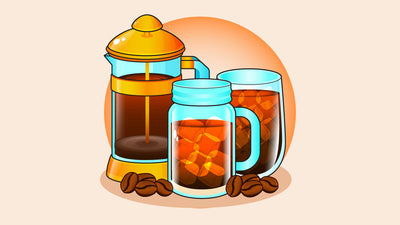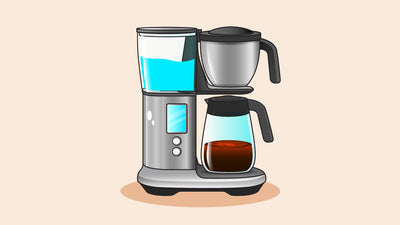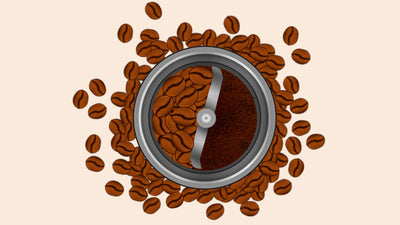The perfect coffee always starts with the right coffee beans. Although most of this is up to personal preference, there are still some universal things you will want to be aware of that affect the flavor of all coffee beans.
The brewing method is important, too, but you don't necessarily need to spend all your money on a fancy espresso machine to make a delicious cup at home. Simple and cheap tools like the French press, phin filter, and pour-over devices can make exceptional coffee if you know what you're doing.
Let’s explore everything you need to know to make great coffee at home — quickly and cheaply.
Choosing Quality Coffee
The best coffee has been freshly roasted, usually within a few days of being shipped out to you. The longer coffee goes between being roasted and being brewed, the more chance it has of going stale, which massively impacts the aroma and flavor.
If your coffee beans don’t have a roast date on the packaging, or the company doesn’t have a policy for freshly roasting before shipping, it’s likely you’re not getting the best beans for your brew.
Good coffee should also have an even roast, meaning that all of the beans have good, consistent coloration. If you notice lots of beans that stick out to you as too light or too dark, the coffee has not been roasted well.
1. Bean Varieties
There are two main varieties of coffee used to make our favorite drink, arabica (the lighter and brighter arabica (Coffea arabica), and the stronger, bolder robusta (Coffea canephora).
Arabica is characterized as being lighter and smoother, often with flavors like citrus, flowers, berries, nuts, and caramel.
Robusta is a lot stronger, both in caffeine content and bold flavors. Robusta coffee has tasting notes including chocolate, malt, earth, dark berries, and pepper.
Coffee Recommendations
The type of coffee bean you prefer is completely up to you and your tastebuds, but if you can’t decide, we recommend starting with a blend.
If you like your coffee to taste as strong and bold as possible — we recommend our BanMe blend, which is a 100% peaberry robusta coffee. It delivers the rich flavors of dark chocolate and cherry and has some of the highest caffeine content you’ll find in a coffee.
If you want something more mellow but still full of flavor — try our 100% arabica DaLat. This luscious coffee carries notes of caramel, stone fruits, and blackberries.
For the best of both worlds, we recommend going for a robusta/arabica blend — such as in our signature SaiGon OG blend which combines the strength of robusta with the smoothness of arabica and the uniqueness of peaberry.
2. Country of Origin
The country your beans come from also plays a key role in their flavor and aroma. Factors like altitude, soil composition, and ambient temperature and humidity dramatically impact the taste of the final brew.
Altitude
A key factor that affects the coffee’s flavor is the altitude at which the coffee plants are grown.
Beans grown at at high altitudes typically grow slower due to the less oxygen-rich conditions, resulting in fruitier and more acidic coffee. This is why high-altitude countries like Colombia are often regarded for having the best-tasting coffee — but this is only true if you like the bright acidity and fruitiness of arabica coffees.
On the other end of the scale, coffee grown at lower altitudes tends to be of the robusta variety, as arabica struggles in these conditions. Lower-altitude robusta coffees have a stronger, more robust flavor, which is disliked by some and favored by others.
Soil Conditions
The country your beans come from can also help you to understand what flavor you should expect. Aside from altitude, the soil conditions play a major role in this distinction.
For example, coffee from Ethiopia has a lot of citrus and tropical fruits running through it thanks to the high mineral commonly found in the soil here.
Brazil's coffee is often sweet and nutty, largely owing to the rich, loamy clay that makes up the greater Cerrado Plateau, where most of the coffee is grown.
Coffee from Vietnam has more earthy and chocolatey notes — associated with the rich volcanic soil found here.
Other Factors
Of course, these are just guidelines, and flavors can vary further depending on the exact location or territory in which the coffee is grown.
For example, there are five provinces within the coffee-growing region of the Central Highlands in Vietnam, with each one bringing its own flavor profile and characteristics.
Related: Different Kinds of Vietnamese Coffee Beans
3. Roast Level
The roast level is one of the biggest factors impacting a coffee’s flavor.
Dark roasts are strong and bold, while lighter roasts are mild and fruity tasting.
Overall, there are 6 key roast levels you’ll find:
- Light roast — Clear, fruity, astringent.
- Medium-light roast — Mild, complex, fruity.
- Medium roast — Balanced, smooth, with hints of caramel.
- Medium-dark roast — Rich, chocolatey, with some spice.
- Dark roast — Bitter, smoky, with a heavy body.
- French roast — Intensely smoky, with a charred sweetness.
While some brewing methods work best with specific roasts — for example, phin filters and espresso machines give the best results with dark roasts — what roast you use ultimately comes down to personal preference.
Related: What Does Vietnamese Coffee Taste Like?
Getting The Grind Right

Knowing how to grind coffee and what grind type to use will help you to get the best out of your coffee.
We usually refer to coffee as being either coarse, medium, or fine, but there are grinds in between.
Each grind will extract different characteristics and flavors depending on your brewing method of choice.
1. Coarsely Ground Coffee
Coarsely ground coffee creates lots of gaps between the coffee grounds that the water can seep through easily. This often results in a milder flavor, as the water has less time to mingle with the coffee before it is extracted.
If the brewing method is not suited for a coarse grind, the coffee will be “under-extracted.” This means that the water has gone through far too quickly, and it hasn’t picked up enough of the flavor from the coffee beans, resulting in a weak, flavorless coffee.
Coarsely ground coffee is primarily used with a French press, percolator device, or to make cold brew, due to its longer steeping time.
There are 3 levels of coarsely ground coffee:
- Coarse — Has the texture of rock salt
- Medium-coarse — Has the texture of rougher beach sand
- Extra-coarse — Has the texture of gravel and is very chunky
2. Medium Ground Coffee
Medium ground coffee is your all-purpose grind, suitable for a variety of brewing methods but especially ideal for auto-drip brewers and pour-over coffee makers.
This grind has a texture similar to sea salt, making it versatile enough to allow adequate extraction while preventing the water from passing through too quickly.
The medium grind is perfect for those who want a balanced extraction, achieving a cup that is neither too weak nor overly bitter. This grind level is often recommended for those new to brewing their own coffee, as it forgivingly balances flavor extraction and brewing time.
There are 3 levels of medium-grind coffee (2 overlap with coarse & fine grinds):
- Standard Medium — Has the texture of sea salt.
- Medium-fine — Slightly finer, like sand.
- Medium-coarse — Has the texture of table salt.
3. Finely Ground Coffee
Finely ground coffee requires grinding the beans to a powder. The coffee granules are small and can pack closer together, meaning that the water takes a lot longer to get through the grounds, thus maximizing the amount of flavor extracted from the beans in less time.
With fine grounds, you run the risk of "over-extracting" your coffee. This is when the water takes too long to get through the grounds, and all of that amazing flavor becomes rather bitter.
Finely ground coffee is most often used in espresso machines, moka pot, AeroPress brewer, or in thick Turkish coffee. Medium-fine coffee is preferred when brewing with a phin filter.
These are the 3 levels of finely ground coffee:
- Medium-fine — Has the texture of regular sand or table salt
- Fine — Has the texture of sugar
- Extra-fine — has the texture of powdered sugar or flour
Tips For Choosing a Coffee Grinder
You may already have a coffee machine that grinds your coffee for you. But, if you truly wish to have full control over your coffee, you may want to invest in a standalone grinder.
There are two types of grinders for coffee available on the market: blade grinders and burr grinders:
- Blade grinders — These are the cheapest and most suitable for beginners. These types of grinders use spinning blades like a blender to cut up and grind your coffee to the desired consistency for brewing.
- Burr grinders — These specialized devices contain burrs (like gears) that rotate and crush the beans down to precise sizes. Many coffee lovers swear by a burr grinder for their beans, as it generates a greater consistency in grind size. They can be quite expensive, however.
How to Care For Your Coffee Grinder
Your grinder will only work as well as you look after it.
Here are some top tips on how to take care of blade and burr grinders:
- Clean your grinder regularly — You can do this by manually cleaning each part or using coffee grinder cleaner tablets.
- Don’t overload your grinder — This puts additional stress on the mechanisms.
- Use high-quality beans — These have a lower oil content, helping to stop the grinder from clogging.
- Check the sharpness of the blades or burrs — This makes sure they can do the job at hand. If you have an inconsistent grind or they are not performing as well, you may need to replace them.
Water Quality & Temperature
It's not just about finding the right beans. The perfect coffee also involves finding the right water to use. While some people might use the water straight out of their faucet, this can sometimes be one of the key problems that cause their coffee not to taste its best.
Water Quality
Hard water contains lots of calcium and magnesium and can lead to a less-than-perfect extraction as the coffee has to fight for space alongside these soluble minerals. On the flip side, soft water often has too few of these minerals, making the coffee taste acidic.
So, what’s the best water to use for your coffee? Filtered water is considered to be the best, as filtration methods help get rid of impurities and any odors that may leech into your coffee. A PH level that is slightly on the acidic side, around 6.5, can help bring the best flavors out of the beans, but that’s tricky to dial in.
Water Temperature
It’s also crucial to consider the water temperature. If it's too hot, it will burn your beans, leading to an unpleasant flavor. Too cold, and you won’t get the best extraction out of the beans.
Aim for a temperature between 85-95℃ or 185-203℉. An easy way to tell without a thermometer is that this is just shy of the boiling point. If you have a kettle or boil water on the stove, either turn it off just before it starts to boil or just let it cool for a couple of minutes after it has reached boiling point and have removed it from the heat.
Brewing Methods & Equipment
Now you've got your coffee and your water ready; you need to decide how you are going to brew your coffee! There are plenty of different coffee brewing methods available, and each has its strengths and weaknesses.
Comparison of 6 Popular Brewing Methods

Explaining Coffee Serving Methods
If you've made it this far, you're not too far off from sampling your perfect coffee. Now, we'll go over how to serve it.
There are countless ways to serve coffee — black, iced, with milk, sweetened, you name it!
Here’s a list of some of the most popular ways to serve coffee from around the globe:
- Vietnamese coffee — either hot or over ice, brewed in a phin with added sweetened condensed milk.
- Espresso shot — a simple black shot of coffee with a good crema.
- Cafe Latte — one part espresso to two parts steamed milk.
- Traditional macchiato — Espresso with a small amount of foamed steamed milk on top.
- Cappuccino coffee — Espresso, equal parts steamed milk and foamed milk, cocoa powder topping.
- Americano coffee — Espresso with hot water.
- Cafe au Lait — Equal parts French Press coffee and scalded milk.
- Affogato — Espresso served over a scoop of vanilla ice cream or gelato.
- Mocha — Espresso, cocoa powder or chocolate syrup, and steamed milk.
These are just the tip of the iceberg—there are many other ways to serve coffee than those on this list. You can even adapt these drinks to better suit your tastes.
For example, lattes and americanos can easily be made hot or iced, and you can experiment with different milk types, including coconut milk, almond milk, and more.
You could even try some more unique combinations from around the world, like traditional Vietnamese egg coffee or espresso martinis.
There's no right or wrong way to serve your coffee — feel free to create your own signature recipe!
How to Store Coffee for Maximum Freshness
Once you have finished making your perfect cup, you’ll want to store your coffee in a way that ensures it stays at its best until the next time you need it.
Coffee should be kept away from heat, moisture, air, and light, so invest in an opaque, airtight container to store your beans and keep it in a cool, dark place.
FAQs: Making Coffee at Home
Still curious about coffee-making tips? Take a look at our FAQs below.
1. What is the best coffee bean for beginners?
Arabica beans are more readily available on the market, so they're easy for beginners to purchase. They're suitable with almost all brewing methods and have a smoother, sweeter flavor perfect for a novice palate. If you’re looking for the best coffee beans for beginners, try Cafely's DaLat, a pure arabica blend full of flavor.
Related: The Differences Between Arabica & Robusta Coffee Explained
2. How long should I brew coffee in a French Press?
Aim for a brewing time of about 4 minutes for optimal flavor extraction. If you want to conserve the heat during the brewing process, you can also wrap a dish towel around the cafetière while you wait.
3. Can I reuse coffee grounds?
While there is nothing stopping you, you’ll soon realize it doesn’t make for a great drink! Most of the amazing flavors and aromas will be left with the first extraction, leaving you with a coffee that is dull and slightly bitter. There are plenty of other ways to use your old coffee grounds, such as in your garden.
4. What's the difference between a burr grinder and a blade grinder?
The difference lies in the mechanism they use to grind your beans. Burr grinders crush the beans between moving and non-moving pair of burrs, and blade grinders use small blades like those you might see at the bottom of your blender. Burr grinders provide a more consistent grind size, which is crucial for flavor extraction, unlike blade grinders which can produce uneven grounds.
5. How does water quality affect coffee taste?
Impurities in water can interfere with the flavors of coffee, making filtered or bottled water a better choice for brewing. You should try to aim for water that has a slightly acidic PH, around 6.5, to truly bring the best out of your coffee.
6. What temperature should water be for brewing coffee?
Ideal water temperatures range from 195-205℉ (85-95℃) for most brewing methods. In essence, it needs to be just shy of boiling to avoid burning your coffee beans.
7. How can I make my coffee less bitter?
There are multiple reasons why your coffee might taste bitter. It could be over-extracted, in which case, try making the grind size coarser or reducing brewing time. Burnt beans are also bitter, so make sure to use the right temperature water. Some coffee types can be naturally more bitter than others, like strong robusta coffee such as Cafely’s BanMe. A small amount of salt can help offset the bitterness. Otherwise, the traditional Vietnamese pairing of sweetened condensed milk works wonders with these brews.
8. Is it necessary to clean my coffee maker regularly?
Yes, cleaning your coffee maker prevents oil build-up and ensures fresh-tasting coffee. The same goes for if you have a standalone grinder, as the oils from the coffee could clog the mechanisms leading to an uneven grind.
9. Can I use tap water to make coffee?
If your tap water tastes good on its own, it's fine for brewing coffee. However, if you live in a hard water area, your water could be too mineral-rich to get the true flavors out of your beans. If in doubt or for a special coffee experience, use filtered water.
10. What is the best way to store coffee beans?
Air, light, moisture, and heat are not best friends with coffee. To maintain freshness, store your coffee beans in an airtight container in a cool, dark place.
















